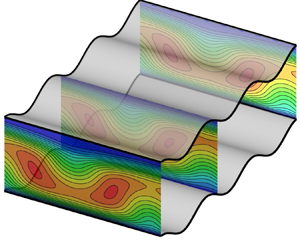Article contents
Flow dynamics in sinusoidal channels at moderate Reynolds numbers
Published online by Cambridge University Press: 29 September 2023
Abstract

Pressure-gradient-driven flows through sinusoidal channels have been studied. The analysis was carried out up to the formation of secondary nonlinear states and spanned a range of low and moderate Reynolds numbers. Direct numerical simulations were used to identify and determine the properties of steady as well as non-stationary, two-dimensional (2-D) and three-dimensional secondary flows. Our results indicate the existence of several distinct solution types. Two-dimensional, stationary flows with periodicity determined by the corrugation represent the first type. The second type is associated with the appearance of 2-D oscillatory flows arising from the onset of unstable travelling waves. Such oscillatory solutions are generally out of phase with the wall corrugation but could be in phase in special cases determined by the ratio of the critical disturbance wavelength and the channel corrugation wavelength. Consequently, several distinct types of time-dependent solutions are possible. The third type of solution results from the centrifugal effect caused by wall curvature and leads to three-dimensionalization of the flow through the onset of stationary streamwise vortices. Finally, various states resulting from the interaction of different solution types are possible. We examine those states and present a bifurcation diagram illustrating the formation of some of them. The results presented in this paper might help with the development of small-scale flow measurement and detection devices operating at low and moderate Reynolds numbers, as well as in the use of wall topographies for the intensification of mixing in flows with moderate, subturbulent Reynolds numbers.
JFM classification
- Type
- JFM Papers
- Information
- Copyright
- © The Author(s), 2023. Published by Cambridge University Press
References
- 2
- Cited by





